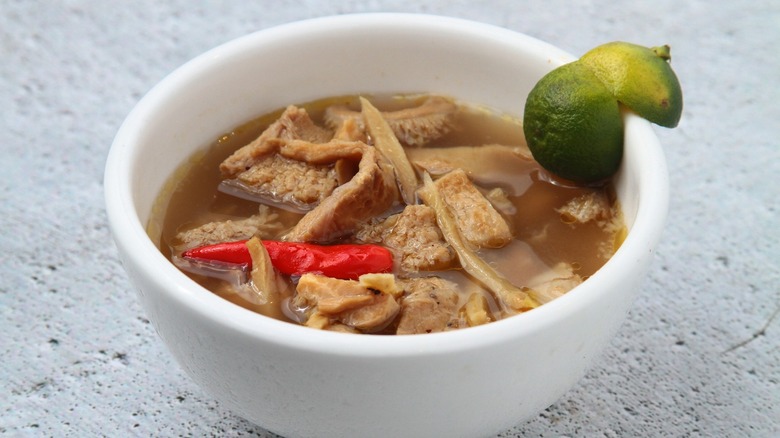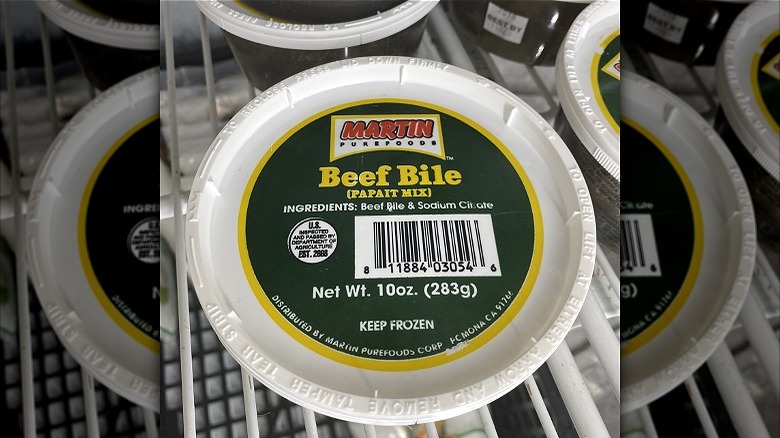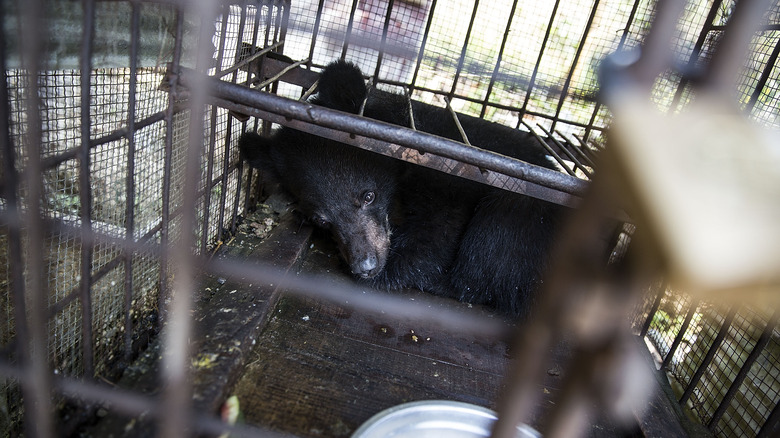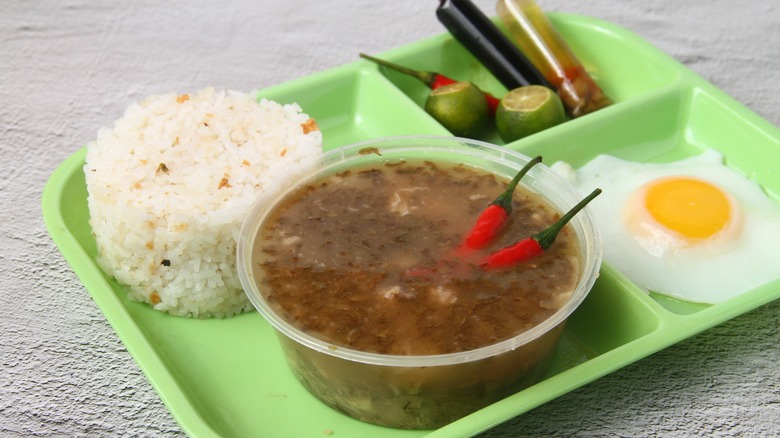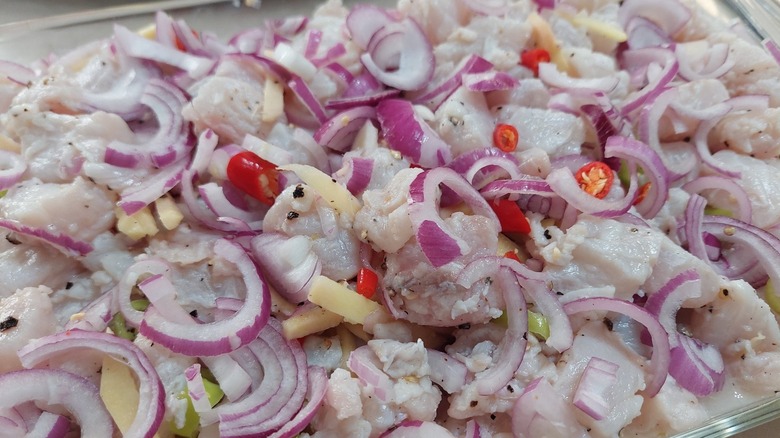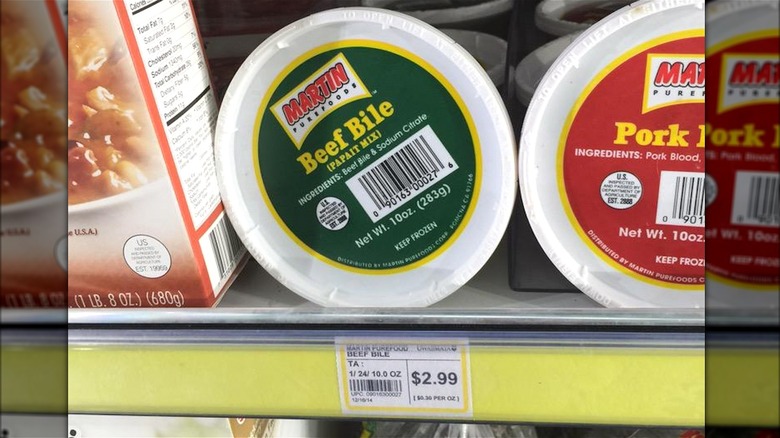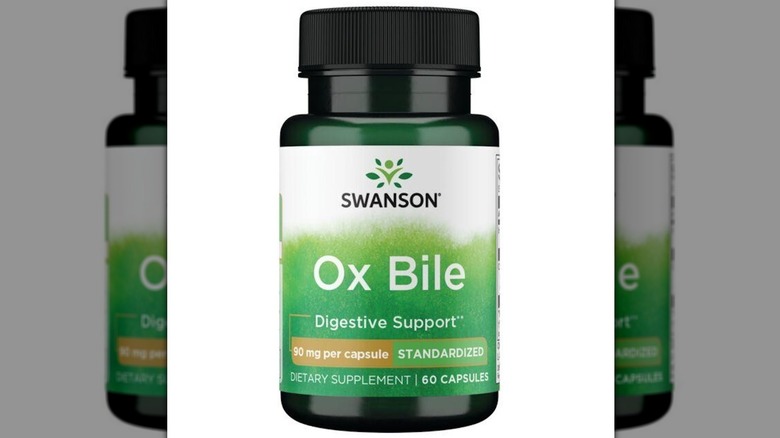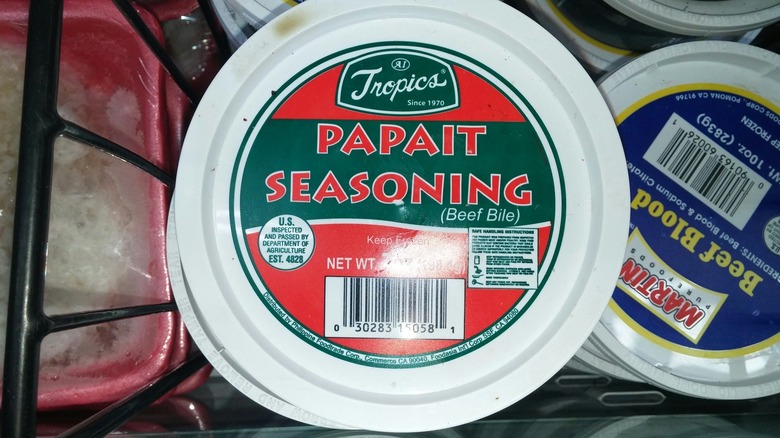What Is Beef Bile And How Do You Use It?
Nose-to-tail eating has been a popular culinary ethos since British chef Fergus Henderson released the seminal cookbook "Nose to Tail Eating: A Kind of British Cooking" in 1999. Thanks to the success of St. John — Henderson's restaurant which is routinely named one of the best places to eat in London, and endorsements by celebrities such as Anthony Bourdain — the nose-to-tail movement gained traction on both sides of the Atlantic. The ethos even set off a similar nose-to-tail trend for fish.
By the mid-2010s, lesser-known cuts, including offal, gained popularity in American restaurants. Partaking in such delicacies was even viewed as a badge of honor, a subtle indication that one had a refined palate and impeccable taste. Perhaps because of this, the nose-to-tail ethos has continued to gain popularity in recent years. However, there are still several animal products that are rarely eaten by the American public. Beef bile is one of these.
As the digestive juices of cattle, beef bile is not likely to break into the American mainstream anytime soon. However, in areas where nose-to-tail eating is a fact of life rather than a culinary fad, adding bile to a dish is relatively common. Usually, the bile is added to boost a dish's flavor, although some people use the ingredient as a digestive aid. Although not widely used, some beef bile products are available in the United States, this gives people the opportunity to cook with this underutilized ingredient and fully embrace Henderson's ethos of nose-to-tail eating.
What is beef bile?
Bile is a digestive fluid secreted by the liver and stored in the gallbladder. It's eventually transported to the intestines to break down fat. This allows the fat molecules to be properly digested and subsequently used by the body.
As the name suggests, beef bile is bile that's been harvested from the innards of cattle. It is available as a health supplement and is used to make various products, including shampoo and soap. The liquid has a long history of being used as medicine. There's proof that beef bile was used to treat eye infections as early as the 10th century. Beef bile is also used as a culinary ingredient in many cultures.
Due to its bitter nature, beef bile is generally used as a flavoring. It is used sparingly, with one teaspoon being the advised serving per each plate of food. Perhaps beef bile's most prominent culinary use is in the preparation of laab dip, a raw beef salad that is coated with a small amount of bile.
Where is beef bile popular?
Beef bile is used across Southeast Asia, in countries such as Laos, the Philippines, and Thailand. In these countries, beef bile is predominantly added to dishes for its flavor, as bile adds a distinctly bitter, vegetal tang. This flavor is an integral part of many Southeast Asian dishes, including laab dip, kinilaw na baka, and beef papaitan.
As with any long-standing ingredient, beef bile is also used because of tradition. Filipino chef Eric Valdez highlighted this perfectly when discussing the use of beef bile at Naks, a tasting restaurant in New York City that spotlights Filipino cuisine. When asked about the ingredients in an interview with Bloomberg, Valdez simply said: "My mother uses these ingredients. She would be mad at me if I used anything else."
Establishments such as Naks are vital to the growth of Southeast Asian cuisines. Aside from raising the profile of certain dishes and the cuisines they come from, these restaurants also introduce Western audiences to new ingredients, such as beef bile. Given enough time, Naks and other restaurants like it might even popularize beef bile in America.
Beef bile vs bear bile
While beef bile remains a relatively niche product, many people have heard of bear bile. This is because bear bile has been a key part of Asian medicinal practices for thousands of years, as the liquid has been used to treat various ailments, including gallbladder stones.
Until the 1980s, the product was not generally considered controversial; people hunted bears and — in an attempt to use the entire animal — harvested the bile. But then, in the 1980s, bears began to regularly be "farmed" for their bile. Bear farming involves keeping the animals in tiny cages for years at a time and repeatedly removing the animal's bile via a slew of invasive methods. These horrific conditions have resulted in several countries banning the practice of bear bile farming.
While beef bile is also used as a medicinal aid to treat gallstones, it's different from bear bile in several ways. First and foremost, the horrific methods used to attain bear bile are not employed by those harvesting beef bile. Instead, beef bile is harvested after an animal has been killed for meat. What's more, beef bile is used for both culinary and medicinal practices. Bear bile, on the other hand, is not used for cooking.
What does beef bile taste like?
As previously mentioned, beef bile has an overwhelmingly bitter flavor. As for just how bitter this ingredient tastes, one person explained on Reddit: "Yes, it's extremely bitter, horrendously bitter, unbearably overpoweringly bitter. It's often the most prominent flavor in the dishes it's featured in."
As cows are raised on a diet of grass, it's unsurprising that beef bile also presents prominently grassy, vegetal notes that can come off as bitter. In some preparations, people seek to diversify this aspect of the bile's flavor by feeding the cow a variety of herbs before it's slaughtered.
Since beef bile is overwhelmingly bitter and grassy, you might wonder why anyone bothers cooking with it. The answer is simple: when the bile is used in scant amounts, it works like fish sauce, adding complexity to the dish. Some even suggest that using beef bile gives the finished dish a distinctly chicken-like flavor. This marks beef bile as one of the many ingredients that taste like chicken.
How to cook with beef bile
In Southeast Asia, beef bile is commonly used in its natural, liquid form. When liquid, beef bile is usually added raw to a dish, little by little. In this manner, it is used to coat salads or flavor soups. As we've seen, beef bile can also be used as a condiment, served alongside dishes like kinilaw na baka, which often utilizes quick-cooked pieces of beef. In almost all these instances, the bile is not cooked.
Beef bile can also be used as a powder that's eventually cooked. For example, one person on Reddit recalled how bile can be dried and used to make kusa, a bitter soup popular in Yunnan, a southwestern province of China: "Before slaughter they feed a bunch of herbs to the cow, then take the bile and dry it into a powder. That powder then forms the base of the soup. That soup's cold and got a bunch of herbs, leek sprouts and a little citrus."
Where to buy beef bile
Beef bile is relatively difficult to buy in the U.S., although it's by no means impossible to find it. Shoppers' best bet is to try visiting their local Southeast Asian grocery store, as these establishments are known to stock a huge array of specialty Asian foods. Many of these stock frozen beef bile products. Martin Pure Foods and Pamana are particularly common brands that produce beef bile products. Other stores might stock powdered beef bile, although this seems to be a much less common product in the U.S.
Another great place to source beef bile is from a local butcher. Even if the store doesn't have access to beef bile, they will likely know someone who does. It's important to note that beef bile bought from these sources will likely be fresh and in its natural, liquid form. This not only affects how long the beef bile will last before spoiling but also how it can be used during the cooking process. Shoppers should plan their recipes accordingly.
Nutritional information about beef bile
As with other animal bile, beef bile has long been used as a gastrointestinal medicine. In the past, it has been used to help dissolve gallbladder stones, aid human digestion of fat molecules, and even increase the absorption of some vitamins and minerals. It's for these reasons that people take beef bile supplements, usually in the form of tablets. Many other people take beef bile supplements to ease digestive issues associated with transitioning to high-fat diets, such as the carnivore diet – one of the wildest weight loss crazes around.
Although there is little empirical evidence, it is reasonable to assume that some of the benefits associated with beef bile supplements can be obtained by eating beef bile in its natural form. Unfortunately, there is scant information comparing the nutritional benefits of beef bile supplementation and the ingestion of beef bile in its natural form. As such, prospective users of beef bile are encouraged to do their own research or contact a health professional before incorporating bile into their diet.
How to store beef bile
The vast majority of Americans are likely to purchase frozen beef bile. In this instance, the beef bile must be kept frozen until all of it is used. Contrary to common belief, freezing does not kill harmful bacteria; it only makes them inactive. This means that once thawed, any microbes active in the bile will multiply, increasing the chances of food-borne illnesses being carried by the bile. Even if kept frozen, there is no guarantee that all parasites in the beef bile have been destroyed. For this reason, the U.S. Department of Agriculture advises thoroughly cooking all raw and unpasteurized animal products, including bile.
If the bile is purchased fresh from the butcher store it should be stored in the refrigerator and be consumed quickly. This is because leaving the bile for extended periods, even in the refrigerator, will give microbes time to multiply. Finally, customers should always ask how fresh the beef bile that they're purchasing is to ensure they have ample time to cook with the bile before it spoils.
